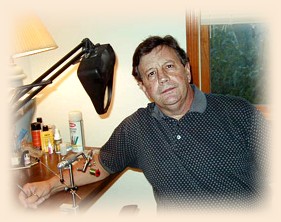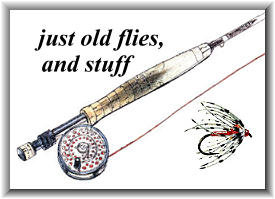There are two other references to the Blue Charm on this site,
both hairwing flies. I've done the featherwing here, and this
fly is a considerable departure from the artistic full dress
salmon flies that I've done in the past. Let me explain.
It started when I met Art Lee in the Catskills in June. As
it turns out, Art is a fanatic salmon fisherman, who travels
the world seeking his quarry. He is one of three people in
the world who've logged over 5000 salmon in his lifetime. On
the second day of the show we were doing, he presented me
with a box of 100 Williams Kirby Limerick blind eye salmon
hooks, #4. I'm not talking about big hooks here, not 4/0,
but smaller hooks for fishing, #4. This is quite close to
a #4 wet fly hook of today, with a slightly longer shank.
These hooks appear to have been made in the 1800s, and the
only reference I've been able to find regarding them is in
a British book from 1850.
I was quite thrilled to obtain these hooks, as you can imagine.
They are quite interesting, as were a box of Carlisle hooks that
he had with him, from Norway. The hook points are bent outward,
at an angle from the shaft, as shown in this picture:
 [Williams Kirby Limerick photo]
[Williams Kirby Limerick photo]
Another interesting facet of these hooks is the roughening of
the shank around the blind eye area. I can only assume that
this is to help the gut grip the shank, and saves the tier a
step. In addition, I find that setting the hook in a vise does
NOT at all compromise the finish on these hooks, nor did I ever
for a second think that it would. I hope that today's makers of
very expensive blind eye hooks will take note of this. It should
not be necessary to encase the bend of the hook in a business
card to "protect" the finish of a hook. If they could make a
solid hook finish in the 1800s, before the industrial revolution,
we should be able to do it today. Call this pet peeve number 3006.
Mr. Lee asked that I tie him "a couple" of flies on these hooks.
He showed me some wonderfully done flies by Clovie Arsenault,
the legendary Canadian tier, and some tied by his long-time
friend Galen Mercer. It was obvious that these flies, fishing
flies, were a far cry from what I'd been doing in the artistic
realm. These flies were built like battleships, with larger
heads, full collar hackle, with durability being the number
one concern.
I set out to do some of these, the Red Abbey because Art Lee
mentioned the fly, and the Blue Charm because I always liked
it. In the interest of durability I took the gut all the way
to the end of the shank, nicked it along its length, bound it
tightly with two complete wraps of thread, and zap-a-gapped
the whole deal along the entire length. This eye is not coming
off, ever. I took a good look at Poul Jorgenson's book Salmon
lies, as I think it best bridges the gap between fishing flies and artistic flies. I wrapped the hackle rather than doing a faux hackle as Jorgenson recommends in his book, because the flies
Art showed me had collared hackles, many in front of the wing.
I've got to think these have more action. I studied flies by
Jerry Doak, Warren Duncan, and Jerome Malloy, the great Canadian
tiers. This has really been fun, educational, and I hope to send
Art Lee a batch of flies soon. Here's the recipe for the Blue Charm:
The Blue Charm
Hook:Williams Kirby Limerick hook, #4 (use whatever suits
our fancy, Tiemco makes some very reasonable eyed hooks in small
sizes that would be perfect)
Tag: Silver tinsel, yellow floss.
Tail: Topping of gold pheasant crest.
Ribbing: Oval silver tinsel.
Body: Black floss.
Hackle: Light blue.
Wing: Bronze mallard with narrow strips of teal over.
Topping: Golden pheasant crest.
Head: Black.
It should be noted that many versions of this fly, more modern
ones, use turkey in the wing. This recipe comes from Salmon
Fishing" by John James Hardy. Many modern recipes also
leave off the topping.
Credits: Salmon Fishing John James Hardy;
The Atlantic Salmon Fly by Judith Dunham; Salmon
Flies, their Character, Style and Dressing by Poul Jorgenson ~ EA
About Eric:
 I started fly fishing as a teen in and around my hometown
of Plattsburgh, New York, primarily on the Saranac River.
I started tying flies almost immediately and spent hours
with library books written by Ray Bergman, Art Lee, and
A. J. McClane. Almost from the beginning I liked tying
just as much as I liked fishing and spent considerable
time at the vise creating hideous monstrosities that
somehow caught fish anyway. Then one day I came upon a
group of flies that had been put out at a local drug store
that had been tied by Francis Betters of Wilmington, N.Y.
My life changed that day and so did my flies, dramatically.
Even though I never met Fran back then, I've always
considered him to be one of my biggest influences.
I started fly fishing as a teen in and around my hometown
of Plattsburgh, New York, primarily on the Saranac River.
I started tying flies almost immediately and spent hours
with library books written by Ray Bergman, Art Lee, and
A. J. McClane. Almost from the beginning I liked tying
just as much as I liked fishing and spent considerable
time at the vise creating hideous monstrosities that
somehow caught fish anyway. Then one day I came upon a
group of flies that had been put out at a local drug store
that had been tied by Francis Betters of Wilmington, N.Y.
My life changed that day and so did my flies, dramatically.
Even though I never met Fran back then, I've always
considered him to be one of my biggest influences.
I had a career in music for twenty years or so and didn't
fish much, though I did fish at times. The band I was with
had its fifteen seconds of fame when we were asked to be in
John Mellencamp's movie "Falling From Grace." I am the
keyboard player on the right in the country club scene in
the middle of the movie. Don't blink. It's on HBO all the
time. We got to meet big Hollywood stars and record in John's
studio. It was a blast.
So how did I wind up contributing to the Just Old Flies
column on FAOL? I'm not sure, it was something that I simply
wanted very badly to do, and they let me. Many of the old flies
take me back to the Adirondacs and my youth, and I guess I get
to relive some of it through the column. I've spent many happy
hours fishing and tying over the years, and tying these flies
brings back memories of great days on the water, and intense
hours spent looking at the flies in the fly plates in the old
books and trying to get my flies to look like them. And now,
here I am, still doing that to this day. ~ EA
|


 [Williams Kirby Limerick photo]
[Williams Kirby Limerick photo] I started fly fishing as a teen in and around my hometown
of Plattsburgh, New York, primarily on the Saranac River.
I started tying flies almost immediately and spent hours
with library books written by Ray Bergman, Art Lee, and
A. J. McClane. Almost from the beginning I liked tying
just as much as I liked fishing and spent considerable
time at the vise creating hideous monstrosities that
somehow caught fish anyway. Then one day I came upon a
group of flies that had been put out at a local drug store
that had been tied by Francis Betters of Wilmington, N.Y.
My life changed that day and so did my flies, dramatically.
Even though I never met Fran back then, I've always
considered him to be one of my biggest influences.
I started fly fishing as a teen in and around my hometown
of Plattsburgh, New York, primarily on the Saranac River.
I started tying flies almost immediately and spent hours
with library books written by Ray Bergman, Art Lee, and
A. J. McClane. Almost from the beginning I liked tying
just as much as I liked fishing and spent considerable
time at the vise creating hideous monstrosities that
somehow caught fish anyway. Then one day I came upon a
group of flies that had been put out at a local drug store
that had been tied by Francis Betters of Wilmington, N.Y.
My life changed that day and so did my flies, dramatically.
Even though I never met Fran back then, I've always
considered him to be one of my biggest influences.